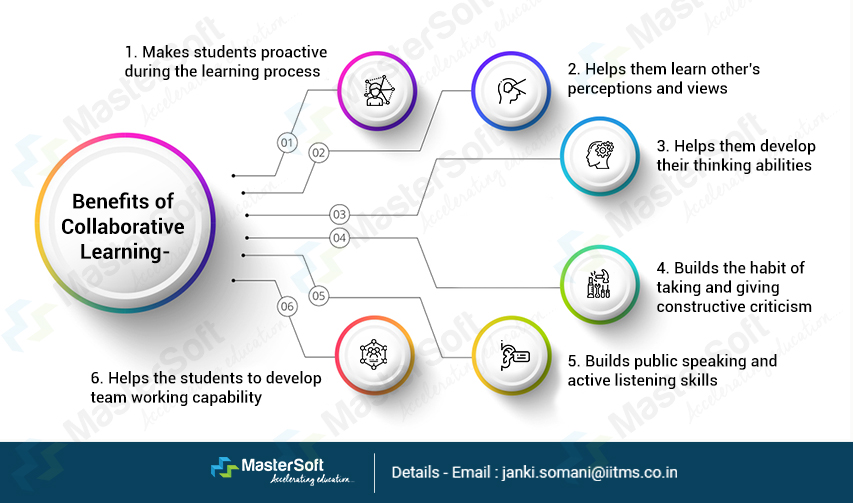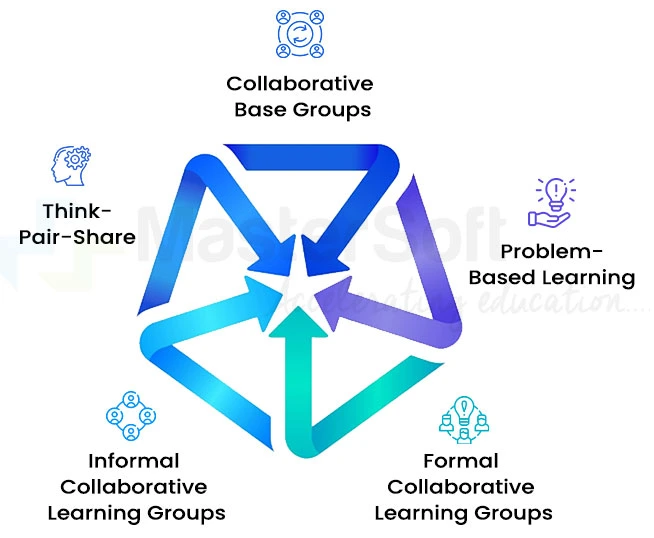29, October 2021
Often indirectly students are forced to memorization at time to often which curtails their critical thinking, creativity, and cognitive abilities since major focus is on the result
We are well aware of the shortcomings in traditional methods of education. They include memorization techniques for learning, and a lack of important skills among the students such as. Hence, many institutes are moving towards adopting new ways of teaching which will lead to students’ overall development and make them ready for the future.
Several colleges and universities have implemented CBCS, OBE, and others to improve their learning outcomes and skills among the students. Collaborative learning is one of the various teaching methods.
What is Collaborative Learning?
Collaborative learning involves groups of students and teachers collaborating on joint intellectual efforts. The majority of the time, students work in groups of two or more people, seeking understanding, solutions, or creating something together.
Collaborative learning is a method of education in which a group of students (two or more) attempts to learn something together using group projects, assignments, etc. In this type of learning, students get the opportunity to learn from others’ skills and resources.
Collaborative learning is an educational approach of teaching and learning in which groups of students participate in solving issues, completing tasks, or creating products together. Collaborative learning flourishes in a social environment, where learners can converse with each other.
The collaborative learning process is a new educational approach in which students study in groups to enhance their learning outcomes. They come together to perform tasks, work on projects and understand new concepts.
The concept of collaborative learning helps the students to actively engage in the processing of new information by putting group efforts instead of making use of memorization techniques for studying. In this way, the students can defend their places, reframe new ideas, understand other people's points of view and gain a better understanding of a subject rather than working as individuals.
What Is Microlearning? Examples & Benefits Of Microlearning
Key Features of Collaborative Learning
- Purpose of the Activity- Collaborative Learning helps to satisfy the purpose of the activity with equal and distributed efforts of all team members.
- Individual Learning Goals- It helps the students to accept new challenges and work on different parts of the projects with help of other students.
- Enhancing Friendships and Teamwork- This helps the students to make friends across the institute having same interests and build a series of network
- Building of New Relationships- Helps students to meet new students, learn about their ways, cultures and work with them.
- Delegation of skills - Distributing the responsibilities of work with the team members as per their experiences, expertise and interest.
Difference Between Cooperative and Collaborative Learning
In cooperative learning, the teacher gives responsibility to each group member to be in charge of the academic performance of other members of the group. Whereas, in the collaborative learning method, the students form groups to learn about new topics.
Collaborative Learning Examples Include
1. Working on the Development of Projects
The teams can work together to understand and identify new niches, work on blueprints, find the best possible solutions, and optimize the use of resources. The project development might require different skills from each member which can be worked out by the students based on their interests and expertise.
2. Sharing Ideas and Concepts
The students can work in teams and share their knowledge and ideas with other teams and vice versa. This will help everyone to learn new subjects and increase their knowledge. Moreover, the students will gain expertise in specific fields.
Benefits of Collaborative Learning

- The students are proactive during the learning process.
- Helps the students to learn other’s perceptions and views
- Helps the students to develop their thinking abilities
- Builds the habit of taking and giving constructive criticism
- Builds public speaking and active listening skills
- Helps the students to develop team working capability
Strategies for Collaborative Learning
1. Clarifying the Group Responsibilities
Before starting the work assignment, it is better to define everyone’s goals in the group which will later help them to take accountability for the tasks.
2. Encourage Open Communications
Open and honest conversations and trust among the group members will help them understand the concepts better and learn thoroughly
3. Conduct a Pre-Test and Post-Test
The instructors can evaluate the students before and after the group learning sessions to understand the outcomes of collaborative learning.
4. Assess the Learning Process
It is well known that the students grow and learn during the process of collaborative learning through discussions and arguments. Hence, they can be evaluated to encourage high-quality discussions.
5. Use Strategies like the Jigsaw Technique
It involves sharing of knowledge and information obtained in the sessions to other teams. This allows one to become thorough in their subject and help others.
6. Allow Group activities to Reduce Anxiety
Allow some humor and entertainment activities in collaborative learning to reduce the tension and anxiety among the students. This will help in creating a friendly environment among the learners.
7. Make use of Real-World Problems
Instead of creating artificial scenarios and issues, the students can use real-life examples to find solutions. This will improve project-based learning among the students.
8. Focus on Enhancing Problem-Solving and Critical Thinking Skills
Give assignments to the students in such a way that they give provision for varied solutions and perceptions.
9. Form Diverse Groups
Groups with mixed people from different countries, genders, and races, give scope for new ideas, varied talents, and learning styles. Further, it helps the students to expand their learning horizons.
10. Make use of Technology for Better Learning Outcomes
Integration of education with technology increases opportunities for the students to indulge in various teaching methods and helps them work efficiently.
Types of Collaborative Learning

- Think-Pair-Share
- Informal Collaborative Learning Groups
- Formal Collaborative Learning Groups
- Problem-Based Learning
- Collaborative Base Groups
This is the most common type of collaborative learning in which the students work independently before and then they engage in discussions in such a way that it exchanges information and ideas among them.
In this type, the class is divided into groups and they are assigned a project to handle. This leads to spending less time on classroom lectures and improves the material retained by students.
In this way of collaborative learning, the group members are required to stay together for weeks or months working on projects. Here, the students study together and apply various approaches to working together.
In this approach, a problem is given for learners in groups, to assess and solve. Here, the students are required to understand a problem before proposing a solution.
Collaborative base organizations consist of groups that are formed to last for at least a year. It includes teams with different perspectives and mindsets so that they can contribute their ideas towards a project.
Importance of Collaborative Learning development among the students
- Collaborative learning enables development of communication and social skills among the students
- It enables the students to learn and develop good habits and gain knowledge from their peers
- The students are required to distribute responsibilities, work together and trust each other
- Students become comfortable in sharing their ideas, discussing strategies and expressing themselves in a group
- Further, it helps them to build a network of people in different fields
- It helps the students to gain confidence and develop important skills for the future.
Teacher’s Role in Collaborative Learning
- Forming groups, and helping students with good environments and activities
- Giving opportunities and tasks that promote collaborative learning
- Structure the groups in such a way that it involves diversity
- Offer resources and study materials to the students
- Conduct assessment of the students in groups
Benefits of Collaborative Learning
1. Encourages Peer Learning
The students learn from their fellow learners. They explain new ideas and concepts to each other better than the teacher.
2. Enables Critical Thinking
The students discuss ideas in groups and give feedback to each other. Understanding and evaluating others’ ideas and opinions improve critical thinking among students.
3. Enables Problem Solving
If a single problem is to be solved by a few people in collaboration, each one of them will be required to solve one part to complete the task, hence improving problem-solving abilities.
4. Improves communication skills
Working together improves communication skills as the students discuss opinions, and ideas, conduct debates, and speak their minds.
5. Improves cultural awareness
Students from different cultures are studying in school. They may have different ideas, beliefs, and ways of working. This will increase students’ awareness.
Examples of Collaborative Learning
1. Working on Projects
Projects involve people working together in groups carrying out different activities, discussing ideas, forming opinions, justifying opinions, and other communication aspects. It also improves the listening abilities of the students as they understand other people's perspectives on the same topic and give them feedback.
2. Conducting Plays/Drama
Conducting plays, playing characters, understanding various parts, and roles, and understanding the depth of various responsibilities to make the play successful helps the students to work in teams, distribute responsibilities and take necessary decisions. It makes them responsible adults for the future.
3. Games and Competitions
Conducting games and competitions forming various groups or individuals increase team spirit and competitiveness among the students. Further, forming teams and playing or performing together makes them trust other students, build compatibility and ensure excellent group ethics in the teams.
4. Group Discussions
Group discussions on a topic help the students to improve their communication skills. It enables them to express their ideas and put those ideas in proper words and make them understandable to others. Further, it helps them become better listeners.
Conclusion
Collaborative learning is gaining importance in various institutions as it helps to focus on various learning aspects of the students. It helps them to improve teamwork, cognitive skills, public speaking skills, and critical thinking. Further, the students are responsible for the ideas and concepts that they build along with better learning outcomes.
How can MasterSoft help in Collaborative Learning?
MasterSoft is a trusted ERP solution provider offering highly advanced learning management systems and other solutions to manage activities and tasks in educational institutes and aid the colleges in implementing different teaching methods.
For collaborative learning, MasterSoft can help the students to form groups and work remotely with the help of software which will allow managing several tasks, uploading assignments, research documents, and sharing knowledge with all the students. Further, it can help the teachers to assess the students and get access to their work in a few clicks. Moreover, the teachers can assess various groups formed separately on the portal and get information about their work updates.
Are you looking for ways, to begin with, collaborative learning in your institute?
Mobile: 08448010216
Email:info@mastersofterp.com
FAQs on Collaborative Learning
Collaborative learning is an educational approach in which students form groups and put collective efforts into a project, assignment, or work assigned to them.
- Increase student’s involvement in classroom activities
- Increase student’s confidence through peer interaction
- Enable cooperation and teamwork among the students
- Encourage the students to have a civic responsibility
Teachers enable collaborative learning by creating tasks that encourage diversity and encourage high performance from all students.













